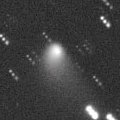
|
Now it is so bright as 9.9 mag (Dec. 12, Juan Jose Gonzalez). It keeps as bright as 9-10 mag for a long time until 2010 spring. It will be observable in good condition for a long time after this in the Northern Hemisphere. It keeps visible visually for one year until 2010 autumn.
Date(TT) R.A. (2000) Decl. Delta r Elong. m1 Best Time(A, h)
Dec. 12 13 9.13 19 29.4 2.452 2.373 73 9.3 5:28 (288, 56)
Dec. 19 13 22.71 21 35.2 2.393 2.399 78 9.3 5:32 (289, 60)
|
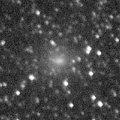
|
It reached up to 8.4 mag in October (Oct. 20, Marco Goiato). It is bright as 8.9 mag still now (Dec. 6, Alexandre Amorim). In the Northern Hemisphere, it keeps observable in the low sky until February when it fades down to 13.5 mag.
Date(TT) R.A. (2000) Decl. Delta r Elong. m1 Best Time(A, h)
Dec. 12 20 43.40 -21 33.5 1.990 1.514 47 9.8 18:19 ( 44, 19)
Dec. 19 21 6.73 -19 54.5 2.054 1.547 46 10.2 18:21 ( 46, 20)
|

|
It reached up to 7.7 mag in summer (Aug. 13, Chris Wyatt). It is fading now, but still bright as 9.4 mag (Dec. 4, Juan Jose Gonzalez). It will be unobservable soon. In the Southern Hemisphere, it will appear in the morning sky in late February, then it keeps observable for a long time. But in the Northern Hemisphere, it is only observable in the low sky in 2010 spring, then it will never be observable again.
Date(TT) R.A. (2000) Decl. Delta r Elong. m1 Best Time(A, h)
Dec. 12 19 26.24 -15 50.5 4.281 3.479 31 10.1 18:19 ( 62, 11)
Dec. 19 19 30.21 -16 41.1 4.375 3.508 25 10.2 18:21 ( 65, 5)
|
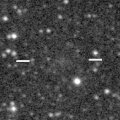
|
Although CCD observers reported it as faint as 14-15 mag, it looks bright visually as 12.9 mag (Nov. 18, Alan Hale). Juan Jose Gonzalez reported it was significantly bright as 9.2 mag on Nov. 18. In the Southern Hemisphere, it keeps observable all through this apparition, although it becomes low in November and December. Especially, it will be observable in the excellent condition after January. In the Northern Hemisphere, it is not observable now. But it will appear in the morning sky at 14 mag in late January, then it keeps observable while fading gradually.
Date(TT) R.A. (2000) Decl. Delta r Elong. m1 Best Time(A, h)
Dec. 12 19 10.67 -38 49.8 0.423 0.648 28 10.2 18:19 ( 47, -7)
Dec. 19 19 1.02 -46 54.6 0.337 0.704 27 10.4 18:21 ( 44,-18)
|
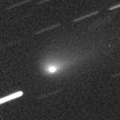
|
It has already brightened up to 10.3 mag (Dec. 12, Juan Jose Gonzalez). It will be observable bright as 9-10 mag in a good condition for a long time from winter to spring. It keeps observable until 2010 autumn when it fades down to 16 mag.
Date(TT) R.A. (2000) Decl. Delta r Elong. m1 Best Time(A, h)
Dec. 12 11 26.13 3 41.2 1.462 1.751 89 11.2 5:28 (343, 58)
Dec. 19 11 41.70 2 17.5 1.379 1.724 92 11.0 5:32 (351, 57)
|
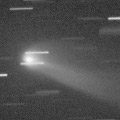
|
An outburst occured on Oct. 13, and it reached up to 8.5 mag on Oct. 15 (Toru Yusa). The central nucleus shined like a bright star, and the dust coma looked like 17P/Holmes in outburst. However, the comet returned to the normal state within a few days. Now it is 11.7 mag (Dec. 12, Juan Jose Gonzalez). It will fade out rapidly, and will be fainter than 14 mag in late January. In the Northern Hemisphere, it keeps observable in good condition for a long time until 2010 spring when it becomes fainter than 18 mag.
Date(TT) R.A. (2000) Decl. Delta r Elong. m1 Best Time(A, h)
Dec. 12 5 57.62 3 8.1 0.732 1.685 157 11.5 0:36 ( 0, 58)
Dec. 19 5 49.86 5 4.3 0.778 1.740 161 11.8 0:01 ( 0, 60)
|

|
Now it is 13.3 mag (Dec. 12, Juan Jose Gonzalez). It was expected to reach up to 12 mag. But actually, it is fainter than expected. In the Northern Hemisphere, it keeps observable in good condition for a long time after this until 2010 spring when it fades out.
Date(TT) R.A. (2000) Decl. Delta r Elong. m1 Best Time(A, h)
Dec. 12 6 1.64 8 13.9 1.033 1.991 161 12.0 0:40 ( 0, 63)
Dec. 19 5 57.14 8 26.9 1.021 1.987 164 11.9 0:08 ( 0, 63)
|
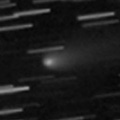
|
It has brightened much faster than expected. Now it is so bright as 11.8 mag (Dec. 12, Juan Jose Gonzalez). It will be fading after January. It keeps observable in good condition for a long time. But it may fade out very rapidly.
Date(TT) R.A. (2000) Decl. Delta r Elong. m1 Best Time(A, h)
Dec. 12 9 53.15 3 30.9 0.634 1.344 110 13.6 4:30 ( 0, 58)
Dec. 19 10 7.22 4 9.5 0.617 1.361 114 13.8 4:17 ( 0, 59)
|

|
Outbursts occured repeatedly since September, and it keeps visible visually. It is bright as 12.0 mag still now (Dec. 12, Juan Jose Gonzalez).
Date(TT) R.A. (2000) Decl. Delta r Elong. m1 Best Time(A, h)
Dec. 12 9 54.06 11 42.0 5.724 6.180 113 13.7 4:32 ( 0, 67)
Dec. 19 9 53.55 11 38.5 5.624 6.182 120 13.7 4:04 ( 0, 67)
|

|
It is expected to reach up to 10 mag and to be observable in good condition in 2010 spring. Now it is not observable. It will appear in the morning sky at 13 mag in late January.
Date(TT) R.A. (2000) Decl. Delta r Elong. m1 Best Time(A, h)
Dec. 12 17 16.18 -31 29.2 3.340 2.370 8 14.4 5:28 (294,-22)
Dec. 19 17 24.86 -30 5.7 3.269 2.300 8 14.2 5:32 (295,-17)
|

|
Now it is not observable. It will appear in the morning sky again in 2010 February. It will brighten up to 12-13 mag in 2010 summer. But it locates somewhat low in the Northern Hemisphere.
Date(TT) R.A. (2000) Decl. Delta r Elong. m1 Best Time(A, h)
Dec. 12 16 20.43 -20 33.8 3.439 2.490 13 14.2 5:28 (291, -6)
Dec. 19 16 34.70 -21 21.0 3.407 2.482 16 14.2 5:32 (294, -3)
|

|
It brightened up to 11 mag in spring and summer in 2009. Now it is not observable. It will appear in the morning sky at 15 mag in early 2010. But it locates somewhat low in the Northern Hemisphere.
Date(TT) R.A. (2000) Decl. Delta r Elong. m1 Best Time(A, h)
Dec. 12 16 25.52 -23 26.4 3.357 2.401 11 14.3 5:28 (293, -8)
Dec. 19 16 40.43 -24 1.9 3.356 2.421 15 14.4 5:32 (296, -6)
|
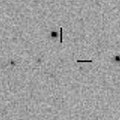
|
Now it is 15.6 mag (Dec. 6, A. Maury, J. B. de Vanssay, F. Mallia, F. Kugel). It will be 14 mag from winter to spring in 2010. But the condition is bad. Now it is not observable in the Northern Hemisphere. But in the Southern Hemisphere, it keeps observable until mid January. In the Northern Hemisphere, it will appear in the morning sky at 15 mag in late May in 2010, then it keeps observable while fading gradually after that.
Date(TT) R.A. (2000) Decl. Delta r Elong. m1 Best Time(A, h)
Dec. 12 20 42.33 -41 4.7 2.424 1.886 46 14.6 18:19 ( 32, 4)
Dec. 19 20 59.71 -37 55.7 2.445 1.856 43 14.5 18:21 ( 36, 5)
|
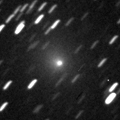
|
It brightened up to 8.5 mag in May and June (May 26, Juan Jose Gonzalez). Now it is fading. It was still bright as 11.6 mag in October (Oct. 10, Marco Goiato). However, it is already too faint to see visually. It will never be observable again in the Northern Hemisphere. In the Southern Hemisphere, it will be low temporarily in winter, but it keeps observable until when it fades out.
Date(TT) R.A. (2000) Decl. Delta r Elong. m1 Best Time(A, h)
Dec. 12 18 22.42 -50 59.8 3.617 2.816 30 14.6 18:19 ( 42,-21)
Dec. 19 18 39.10 -50 8.3 3.718 2.893 28 14.8 18:21 ( 44,-22)
|
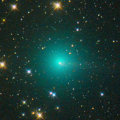
|
It brightened up to 6.7 mag in June (June 9, Marco Goiato). Now it is 13.6 mag (Nov. 23, Ken-ichi Kadota), a bit brighter than this ephemeris. It must be visible visually still now. It will be fading after this, and keeps observable until next spring when it becomes fainter than 18 mag.
Date(TT) R.A. (2000) Decl. Delta r Elong. m1 Best Time(A, h)
Dec. 12 13 41.29 19 51.3 2.988 2.769 67 14.7 5:28 (281, 49)
Dec. 19 13 42.17 22 3.1 2.921 2.830 74 14.9 5:32 (284, 57)
|
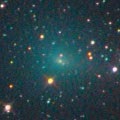
|
It brightened up to 8.8 mag in May and June (May 19, Juan Jose Gonzalez). It has already faded down to 15.3 mag (Dec. 10, Toru Yusa). It keeps observable in the evening sky for a long time until next spring when it becomes fainter than 18 mag.
Date(TT) R.A. (2000) Decl. Delta r Elong. m1 Best Time(A, h)
Dec. 12 23 28.76 -8 42.7 2.231 2.430 89 15.1 18:19 ( 5, 46)
Dec. 19 23 37.22 -7 39.0 2.360 2.472 84 15.4 18:21 ( 13, 47)
|
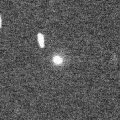
|
New periodic comet, brightened very rapidly. Now it is 14.8 mag and visible visually (Dec. 4, Juan Jose Gonzalez). It is observable at 15 mag in good condition in winter.
Date(TT) R.A. (2000) Decl. Delta r Elong. m1 Best Time(A, h)
Dec. 12 1 51.70 -3 42.4 1.050 1.792 123 15.2 20:27 ( 0, 51)
Dec. 19 1 58.62 -5 18.9 1.096 1.777 117 15.2 20:06 ( 0, 50)
|

|
It brightned up to 10 mag from late 2008 to early 2009. Now it is fading. But it is still bright as 15.3 mag (Nov. 2, Ken-ichi Kadota). It will be observable in good condition again in winter at 15 mag. Then it may be still visible visually.
Date(TT) R.A. (2000) Decl. Delta r Elong. m1 Best Time(A, h)
Dec. 12 10 27.49 4 37.4 4.840 5.151 103 15.2 5:05 ( 0, 60)
Dec. 19 10 26.82 4 14.8 4.785 5.206 110 15.2 4:37 ( 0, 59)
|
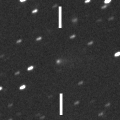
|
Now it is 14.3 mag, already visible visually (Dec. 9, Alan Hale). It will be observable at 15 mag in good condition in winter and spring.
Date(TT) R.A. (2000) Decl. Delta r Elong. m1 Best Time(A, h)
Dec. 12 5 13.06 13 20.3 1.210 2.186 170 15.3 23:47 ( 0, 68)
Dec. 19 5 6.97 13 39.8 1.189 2.158 166 15.2 23:13 ( 0, 69)
|

|
It passed near by the earth in late February in 2009, and it reached up to 4.9 mag (Feb. 23, Juan Jose Gonzalez). Now it is fading, but still bright as 15.5 mag (Nov. 14, Ken-ichi Kadota). It will be low in the evening sky at 17-18 mag in 2010 spring.
Date(TT) R.A. (2000) Decl. Delta r Elong. m1 Best Time(A, h)
Dec. 12 5 44.13 21 23.0 3.435 4.414 173 15.3 0:23 ( 0, 76)
Dec. 19 5 32.44 21 16.9 3.501 4.483 175 15.4 23:38 ( 0, 76)
|

|
It brightened up to 11.5 mag in 2008 summer (Aug. 4, Marco Goiato). Now it is 15.6 mag (Oct. 31, Hidetaka Sato). It keeps observable in good condition for a long time in the Southern Hemisphere. Now it became observable again also in the Northern Hemisphere. It will keep 15-16 mag until next spring.
Date(TT) R.A. (2000) Decl. Delta r Elong. m1 Best Time(A, h)
Dec. 12 5 25.64 -41 19.1 4.180 4.690 115 15.3 0:04 ( 0, 14)
Dec. 19 5 16.67 -40 22.6 4.230 4.742 115 15.4 23:22 ( 0, 15)
|

|
It will pass the perihelion in late December. It will brighten very rapidly near by the perihelion. However, the condition is very bad in this apparition. Extremely hard to recover.
Date(TT) R.A. (2000) Decl. Delta r Elong. m1 Best Time(A, h)
Dec. 12 18 18.57 -24 4.5 1.783 0.864 14 15.8 18:19 ( 65, -7)
Dec. 19 18 56.98 -24 0.2 1.739 0.837 15 15.4 18:21 ( 64, -5)
|
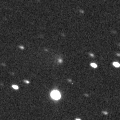
|
Now it is 16.4 mag (Nov. 3, Ken-ichi Kadota). It will reach up to 12 mag in 2012, and will be observable visually at 12-13 mag for a long time from 2011 to 2013. In 2009, it is observable in good condition at 16 mag from summer to autumn. In the Northern Hemisphere, the comet will be low around its brightest seasons.
Date(TT) R.A. (2000) Decl. Delta r Elong. m1 Best Time(A, h)
Dec. 12 21 37.62 -1 13.3 8.387 8.052 66 15.7 18:19 ( 46, 43)
Dec. 19 21 37.93 -1 20.2 8.462 8.016 60 15.7 18:21 ( 54, 39)
|
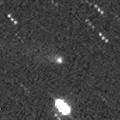
|
Getting higher again in the morning sky. It will be observable at 15-16 mag in good condition from winter to spring.
Date(TT) R.A. (2000) Decl. Delta r Elong. m1 Best Time(A, h)
Dec. 12 15 42.77 20 59.6 3.433 2.894 49 15.8 5:28 (261, 25)
Dec. 19 15 43.73 20 44.7 3.391 2.914 53 15.8 5:32 (266, 31)
|

|
It was observed as 15-16 mag in early 2009. In 2010, it will be observable at 15.5 mag in good condition from winter to spring.
Date(TT) R.A. (2000) Decl. Delta r Elong. m1 Best Time(A, h)
Dec. 12 13 20.36 -2 19.0 3.966 3.588 60 16.1 5:28 (309, 39)
Dec. 19 13 26.98 -2 52.5 3.877 3.592 66 16.0 5:32 (316, 42)
|

|
It brightened up to 13 mag and observed visually from 2007 to 2009. Due to the far distance, it is bright as 15.5 mag still now (Oct. 30, Ken-ichi Kadota). It will be observable in good condition again from winter to spring.
Date(TT) R.A. (2000) Decl. Delta r Elong. m1 Best Time(A, h)
Dec. 12 13 28.33 31 40.0 7.604 7.448 77 16.1 5:28 (264, 57)
Dec. 19 13 28.44 32 13.1 7.533 7.479 83 16.1 5:32 (267, 64)
|

|
Now it is 16.7 mag (Nov. 15, Catalina Sky Survey). It will be observable at 15.5 mag in the evening sky from winter to spring.
Date(TT) R.A. (2000) Decl. Delta r Elong. m1 Best Time(A, h)
Dec. 12 1 55.19 31 16.5 1.145 1.968 134 16.2 20:29 ( 0, 86)
Dec. 19 1 38.35 33 17.5 1.160 1.905 125 16.1 19:45 ( 0, 88)
|

|
Now it is 16.6 mag (Dec. 8, C. Rinner, F. Kugel). The condition of this apparition is bad. It will reach up to 11-12 mag from spring to autumn in 2010, but it is not observable. It will be getting brighter gradually in the evening sky, but it will be too low to observe in January at 15 mag.
Date(TT) R.A. (2000) Decl. Delta r Elong. m1 Best Time(A, h)
Dec. 12 21 9.75 -1 39.6 2.766 2.436 60 16.3 18:19 ( 53, 39)
Dec. 19 21 19.64 -1 19.3 2.795 2.388 55 16.2 18:21 ( 58, 36)
|

|
Now it is 18.0 mag (Nov. 21, C. Rinner, F. Kugel). It is expected to brighten rapidly and to be observable at 15 mag in good condition from winter to spring. However, it is fainter than this ephemeris recently.
Date(TT) R.A. (2000) Decl. Delta r Elong. m1 Best Time(A, h)
Dec. 12 10 23.12 17 11.0 1.853 2.358 108 16.5 5:00 ( 0, 72)
Dec. 19 10 29.08 17 7.3 1.762 2.344 114 16.3 4:39 ( 0, 72)
|
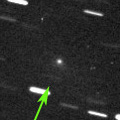
|
It brightened up to 11 mag in outburst in 2003. However, it does not seem to be so bright in this apparition. Now it is 16.3 mag (Nov. 18, J. M. Ruiz, G. Muler). It will be observable in good condition in winter. But it seems to brighten only up to 16 mag.
Date(TT) R.A. (2000) Decl. Delta r Elong. m1 Best Time(A, h)
Dec. 12 23 44.24 9 56.3 1.063 1.572 100 16.4 18:20 ( 0, 65)
Dec. 19 23 54.97 10 28.0 1.083 1.536 95 16.3 18:21 ( 11, 65)
|

|
It passed the perihelion in September, and brightened up to 14.6 mag (Sept. 19, Hidetaka Sato). It is fading now, but still bright as 16.1 mag (Nov. 11, Hidetaka Sato). It keeps observable in good condition until February when it becomes fainter than 18 mag.
Date(TT) R.A. (2000) Decl. Delta r Elong. m1 Best Time(A, h)
Dec. 12 22 20.72 6 31.4 1.562 1.695 79 16.6 18:19 ( 39, 56)
Dec. 19 22 35.46 9 7.1 1.678 1.752 77 16.7 18:21 ( 47, 56)
|
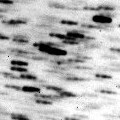
|
The condition is good in this apparition. It approached to the earth down to 0.38 A.U., and brightened up to 15.9 mag (Nov. 24, A. Sanchez). It is still bright as 16.0 mag (Dec. 11, A. Sanchez). It will fading after this. It will be fainter than 18 mag in mid January.
Date(TT) R.A. (2000) Decl. Delta r Elong. m1 Best Time(A, h)
Dec. 12 0 18.86 6 15.8 0.457 1.199 106 16.6 18:56 ( 0, 62)
Dec. 19 0 56.33 9 16.8 0.511 1.251 109 16.8 19:06 ( 0, 64)
|
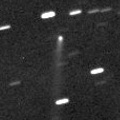
|
Now it is 16.8 mag (Dec. 5, A. Sanchez). It has a very long tail in spite of the distance. It passed the perihelion in 2009, but it was brighter in 2008. It will be fading after this, and will be fainter than 18 mag in next spring.
Date(TT) R.A. (2000) Decl. Delta r Elong. m1 Best Time(A, h)
Dec. 12 22 54.98 31 32.2 3.839 4.087 97 16.7 18:19 ( 75, 79)
Dec. 19 22 56.15 31 46.0 3.950 4.106 92 16.8 18:21 ( 84, 74)
|

|
Fading slowly. Now it is 16.6 mag (Nov. 15, Catalina Sky Survey). It keeps observable in good condition until February when it becomes fainter than 18 mag.
Date(TT) R.A. (2000) Decl. Delta r Elong. m1 Best Time(A, h)
Dec. 12 10 17.34 8 40.2 1.943 2.420 106 16.7 4:55 ( 0, 64)
Dec. 19 10 17.31 8 13.0 1.907 2.474 113 16.8 4:27 ( 0, 63)
|
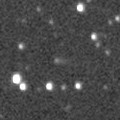
|
Now it is 16.1 mag (Dec. 5, J. Castellano). This comet tends to brighten after the perihelion passage. It will be observable at 16-17 mag in 2010 and 2011.
Date(TT) R.A. (2000) Decl. Delta r Elong. m1 Best Time(A, h)
Dec. 12 4 35.17 24 36.8 2.222 3.198 170 16.8 23:09 ( 0, 80)
Dec. 19 4 30.52 24 20.7 2.242 3.194 162 16.8 22:37 ( 0, 79)
|
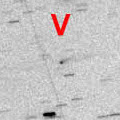
|
New periodic comet discovered very near by 29P/Schwassmann-Wachmann 1 and 81P/Wild 2. Now it is 17.2 mag (Nov. 3, Ken-ichi Kadota). It will be fainter than 18 mag in March.
Date(TT) R.A. (2000) Decl. Delta r Elong. m1 Best Time(A, h)
Dec. 12 10 58.42 13 1.1 1.534 1.949 99 17.0 5:28 (355, 68)
Dec. 19 11 4.97 13 35.2 1.497 1.991 104 17.1 5:15 ( 0, 69)
|
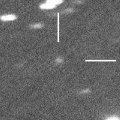
|
Now it is 17.4 mag (Nov. 6, C. Rinner, F. Kugel). It keeps observable at 17 mag for a long time from 2010 to 2012.
Date(TT) R.A. (2000) Decl. Delta r Elong. m1 Best Time(A, h)
Dec. 12 2 38.95 18 21.1 7.851 8.658 143 17.3 21:13 ( 0, 73)
Dec. 19 2 34.58 18 6.5 7.920 8.642 134 17.4 20:42 ( 0, 73)
|
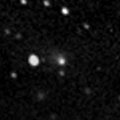
|
It brightened up to 15-16 mag in 2008 summer. Now it is 17.2 mag (Dec. 6, A. Garrigos S., T. Garrigos S., C. Garrigos S.). It will be fainter than 18 mag in January.
Date(TT) R.A. (2000) Decl. Delta r Elong. m1 Best Time(A, h)
Dec. 12 3 7.65 34 33.0 2.405 3.293 149 17.5 21:42 ( 0, 90)
Dec. 19 3 4.20 34 7.1 2.473 3.312 142 17.6 21:11 ( 0, 89)
|

|
It will be observable at 17.5 mag in good condition in winter.
Date(TT) R.A. (2000) Decl. Delta r Elong. m1 Best Time(A, h)
Dec. 12 10 2.10 30 9.4 2.439 3.013 116 17.7 4:40 ( 0, 85)
Dec. 19 10 4.44 30 45.2 2.367 3.019 123 17.7 4:14 ( 0, 86)
|
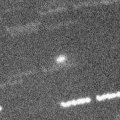
|
It was bright as 16.8 mag in November (Nov. 14, Ken-ichi Kadota). Now it is fading. It will be fainter than 18 mag in late December.
Date(TT) R.A. (2000) Decl. Delta r Elong. m1 Best Time(A, h)
Dec. 12 0 54.85 21 26.7 1.653 2.308 120 17.7 19:28 ( 0, 76)
Dec. 19 0 34.48 19 58.7 1.792 2.298 108 17.9 18:41 ( 0, 75)
|

|
It will be observable at 17.5 mag in good condition in early 2010 and early 2011.
Date(TT) R.A. (2000) Decl. Delta r Elong. m1 Best Time(A, h)
Dec. 12 5 43.75 20 17.4 2.636 3.615 173 17.8 0:22 ( 0, 75)
Dec. 19 5 38.63 20 20.8 2.624 3.607 176 17.7 23:45 ( 0, 75)
|

|
New periodic comet which brightened up to 14 mag in 2004 and 2005. It should be observable at 18 mag also around the aphelion. However, no observations have been reported since 2008 January. It seems to have faded out rapidly. Now it is fainter than 20.4 mag actually (Sept. 16, Leonid Elenin).
Date(TT) R.A. (2000) Decl. Delta r Elong. m1 Best Time(A, h)
Dec. 12 6 58.45 29 30.2 4.084 5.001 156 17.8 1:37 ( 0, 84)
Dec. 19 6 53.97 29 49.8 4.041 4.994 163 17.8 1:05 ( 0, 85)
|
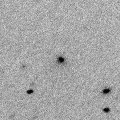
|
It was originally predicted to be 19 mag. However, it brightened rapidly and reached up to 15.7 mag in October (Oct. 24, L. Donato, V. Gonano, E. Guido, V. Santini, G. Sostero). However, it is fading rapidly now. It has already faded down to 17.9 mag (Nov. 21, Ken-ichi Kadota).
Date(TT) R.A. (2000) Decl. Delta r Elong. m1 Best Time(A, h)
Dec. 12 0 37.25 12 44.9 1.642 2.225 113 17.8 19:13 ( 0, 68)
Dec. 19 0 42.17 13 37.5 1.727 2.233 107 18.1 18:50 ( 0, 69)
|
|
![]()
 C/2006 S3 ( LONEOS )
C/2006 S3 ( LONEOS ) C/2008 N1 ( Holmes )
C/2008 N1 ( Holmes ) 74P/Smirnova-Chernykh
74P/Smirnova-Chernykh C/2005 L3 ( McNaught )
C/2005 L3 ( McNaught ) C/2009 U3 ( Hill )
C/2009 U3 ( Hill ) 43P/Wolf-Harrington
43P/Wolf-Harrington 94P/Russell 4
94P/Russell 4 157P/Tritton
157P/Tritton (3552) Don Quixote
(3552) Don Quixote 107P/(4015) Wilson-Harrington
107P/(4015) Wilson-Harrington C/2008 P1 ( Garradd )
C/2008 P1 ( Garradd ) 64P/Swift-Gehrels
64P/Swift-Gehrels 203P/2008 R4 ( Korlevic )
203P/2008 R4 ( Korlevic ) P/2009 U6 ( LINEAR )
P/2009 U6 ( LINEAR ) C/2008 S3 ( Boattini )
C/2008 S3 ( Boattini ) 47P/Ashbrook-Jackson
47P/Ashbrook-Jackson P/2009 W1 ( Hill )
P/2009 W1 ( Hill ) C/2009 T3 ( LINEAR )
C/2009 T3 ( LINEAR ) 31P/Schwassmann-Wachmann 2
31P/Schwassmann-Wachmann 2 P/2004 F3 ( NEAT )
P/2004 F3 ( NEAT ) 127P/Holt-Olmstead
127P/Holt-Olmstead![]()




































